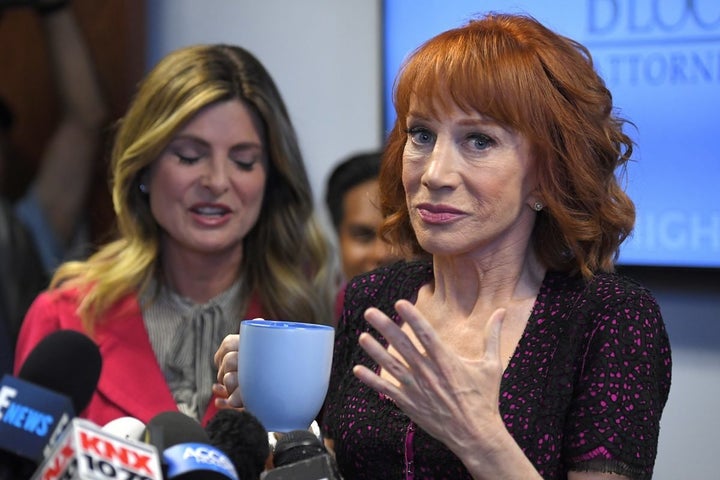
Originally published by the Philadelphia Inquirer
By now, anyone with a television or the Internet is aware of Kathy Griffin’s misfired attempt at humor by posing with a replica of President Trump’s bloody, disembodied head. At its best, this stunt could be considered comedic. At worst, it’s just… the worst. (Philly.com’s Jenice Armstrong called the action “offensive,” “horrific,” “morbid” and “grotesque.”) I’m not sure why a depiction of the president’s bloody head hanging from your hand should be considered funny. Griffin made a political statement that stood miles away from any claim of humor. Griffin herself called it a “horrible, horrible call.”
But I come not to rail against Kathy Griffin, nor to praise her.
Instead, I want to speak in the defense of political satire, which can connect people to news and politics in a way that traditional reporting can’t always do. As a disclaimer, I knew Kathy Griffin before she ever stepped on stage as a comedian. I met her when she worked backstage at the Groundlings improvisation theater in Los Angeles. Back then, Griffin was shy compared to other performers and she had to be talked into going on stage by Philadelphia native and comedian, Judy Toll. Toll’s advice to Griffin was not to worry about being a comic and instead just speak her mind. It seems that she took Toll’s advice to heart with her most recent stunt. Explained by Griffin, the Trump photos were created to reflect candidate Trump’s crude reference to then-Fox News host, Megyn Kelly, having blood coming out of her “whatever.” People on both sides of the aisle have taken to social media to passionately debate whether Griffin’s actions were simply bad comedy or an act of treason. But one thing is clear to me: This was not political satire—and to call it that is an injustice to what political satire is supposed to be. Merriam-Webster defines “satire” as: (sharp) wit, irony, or sarcasm used to expose and discredit vice or folly.
“When done well, the impact of satire can be even more important than the news itself.”
Satire, especially political satire, is just as important as serious reporting. It’s also just as protected by the Constitution. Sometimes satire is purely about getting a laugh, but sometimes it’s about getting a laugh and making a point. When done well, the impact of satire can be even more important than the news itself. Satire’s humorous elements can bring in a wider audience than the original reporting. Satire connects audiences to news and can sometimes be the first exposure that younger, less savvy audiences have when it comes to newsworthy issues of the day. If satirical observations voice your point of view, you not only laugh with the satirists, but you cheer them on as well. Whether written for sites like The Onion or National Lampoon or performed on stage, political satirists like Will Rogers, Lenny Bruce, Mort Sahl, Jon Stewart and Bill Hicks have made fun of politicians and heads of state for decades. More recently, the New Yorker‘s Andy Borowitz and late-night TV’s Samantha Bee and John Oliver have unleashed their own unrelenting brands of satire on our current president, with jokes about everything from his policies to his fashion choices. (In fact, in February, Inquirer television critic Ellen Gray wondered if all-Trump-all-the-time programming on late night TV would prevent humorous late-night shows from shedding lighter on under-covered stories.) Political satire has perhaps seen it’s most popular resurgence through this season of Saturday Night Live thanks to unrelenting satirical portrayals of Trump and his administration, especially Alec Baldwin’s portrayal of Trump’s eccentricities and Melissa McCarthy’s Sean Spicer character.
It’s not always the left satirizing the right. Will Rogers became known as a non-partisan satirist when he said, “I belong to no organized party. I am a Democrat.” When I was the political editor at National Lampoon, we created a spoof site of progressive Moveon.org. The satirical Moveonplease.org mocked Moveon.org’s left-leaning depiction of right-wing issues. The right-leaning audience loved it because it represented a point of view they agreed with in a way that made them laugh.
The difference between those examples and Griffin’s photos is simple: Griffin’s photo was not political satire at all. It was “political art.” That’s what Griffin’s photographer, Tyler Shields called it when he tweeted, “Can you go to jail for making an artistic statement?” Whether it was appreciated or not, the photos of Griffin holding a faux bloody Trump head were political art, not satire.
So please, don’t confuse Griffin’s stunt with the important satirical work that’s done by sites like The Onion or shows like Saturday Night Live. Satire has its place when done well. This wasn’t it.
Steve Young is an award-winning TV writer, author and former political editor of National Lampoon. See more at www.greatfailure.com.